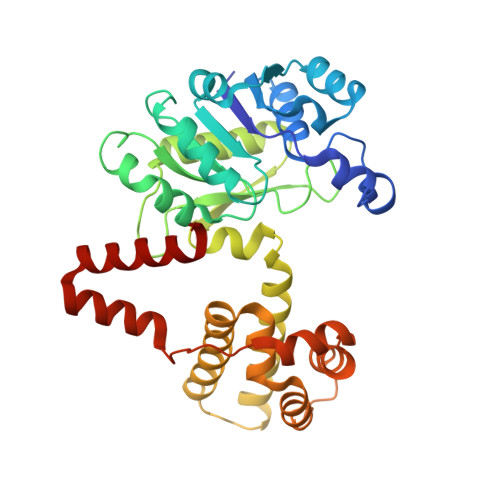Towards a functional identification of catalytically inactive [Fe]-hydrogenase paralogs.
Fujishiro, T., Ataka, K., Ermler, U., Shima, S.(2015) FEBS J 282: 3412-3423
- PubMed: 26094576
- DOI: https://doi.org/10.1111/febs.13351
- Primary Citation of Related Structures:
4YT2, 4YT4, 4YT5, 4YT8 - PubMed Abstract:
[Fe]-hydrogenase (Hmd), an enzyme of the methanogenic energy metabolism, harbors an iron-guanylylpyridinol (FeGP) cofactor used for H2 cleavage. The generated hydride is transferred to methenyl-tetrahydromethanopterin (methenyl-H4MPT(+)). Most hydrogenotrophic methanogens contain the hmd-related genes hmdII and hmdIII. Their function is still elusive. We were able to reconstitute the HmdII holoenzyme of Methanocaldococcus jannaschii with recombinantly produced apoenzyme and the FeGP cofactor, which is a prerequisite for in vitro functional analysis. Infrared spectroscopic and X-ray structural data clearly indicated binding of the FeGP cofactor. Methylene-H4MPT binding was detectable in the significantly altered infrared spectra of the HmdII holoenzyme and in the HmdII apoenzyme-methylene-H4 MPT complex structure. The related binding mode of the FeGP cofactor and methenyl-H4MPT(+) compared with Hmd and their multiple contacts to the polypeptide highly suggest a biological role in HmdII. However, holo-HmdII did not catalyze the Hmd reaction, not even in a single turnover process, as demonstrated by kinetic measurements. The found inactivity can be rationalized by an increased contact area between the C- and N-terminal folding units in HmdII compared with in Hmd, which impairs the catalytically necessary open-to-close transition, and by an exchange of a crucial histidine to a tyrosine. Mainly based on the presented data, a function of HmdII as Hmd isoenzyme, H2 sensor, FeGP-cofactor storage protein and scaffold protein for FeGP-cofactor biosynthesis could be excluded. Inspired by the recently found binding of HmdII to aminoacyl-tRNA synthetases and tRNA, we tentatively consider HmdII as a regulatory protein for protein synthesis that senses the intracellular methylene-H4 MPT concentration. Structural data are available in the Protein Data Bank under the accession numbers 4YT8; 4YT2; 4YT4 and 4YT5.
Organizational Affiliation:
Max-Planck-Institut für terrestrische Mikrobiologie, Marburg, Germany.
















